 Pre-employment screening
Pre-employment screening
Unlocking the power of background screening reports
In today's fast-paced and interconnected world, the importance of making informed decisions cannot be overstated, especially when it comes to hiring employees or forming business partnerships. One powerful (yet understated) tool at the disposal of employers and organisations to ensure they're bringing in trustworthy individuals, is the background screening report.
In this article, we take a look at what a background screening report is, the importance of what a background screening report can give, and how our automated screening software can help you produce one.
What is a background screening report?
There can be two meanings and understanding for what a background screening report is. Firstly, the report you receive following the completion of a background check or series of background checks for a specific role or individual. And secondly, reporting on all the background checks conducted within your screening platform. Either way, these comprehensive documents provide critical insights that can help businesses and employers make well-informed choices throughout their hiring processes.
Let’s focus on the first type quickly! A background screening report following the completion of a background check is far more than a brief look at an individual's past. It's a complex step by step dive into an individual’s credentials to uncover a range of information, from a person's criminal history and creditworthiness to their employment history and character references. In today's competitive job market and business landscape, organisations need to ensure they are not only attracting top talent but also safeguarding their interests.
As for the second type, reporting on compliance background check screening activities during the recruitment of new hires involves an organised approach to document and communicate the results of the screening process.
How can businesses report on their background screening processes?
Here's a step-by-step on how businesses can effectively report on their compliance background check screening activities:
- Define reporting parameters: Determine what information needs to be included in the compliance background check screening report. This may involve educational qualifications, employment history, criminal records, credit history, and any other relevant checks specific to the role or industry.
- Integrate reporting within SaaS platform: Ensure that your SaaS-based screening product has reporting features that allow you to generate comprehensive reports on each candidate's screening results.
- Generate candidate reports: For each candidate, generate a detailed report that summarises the results of the background check screening process. Include clear headings and sections for different types of checks conducted.
- Provide context and explanation: If any discrepancies or concerns arise from the screening process, provide context and explanations within the report. Highlight any actions taken to address or resolve these concerns.
- Highlight compliance: Clearly indicate that the screening process has been conducted in compliance with relevant laws and regulations. Include disclaimers and disclosures as necessary.
- Ensure data privacy: Respect candidate privacy by handling sensitive information appropriately. Securely store and transmit reports, ensuring that only authorised personnel have access.
- Customise reporting templates: Depending on the needs of your business and industry, customise reporting templates to present information in a clear and standardised manner.
- Include contact information: Provide contact information for inquiries or concerns related to the screening results. Candidates should know who to reach out to if they have questions about the report.
- Implement regular audits: Conduct periodic audits of your reporting processes to ensure accuracy, consistency, and compliance. Address any issues that arise promptly.
- Internal and external distribution: Share the screening reports with relevant internal stakeholders, such as hiring managers and HR personnel, as well as external parties if required by law or policy.
- Archival and retention: Maintain organised records of all screening reports in a secure and accessible manner. Ensure compliance with data retention regulations.
- Candidate consent and communication: Throughout the screening process, ensure that candidates are informed about the background check and have provided necessary consent. Communicate openly and transparently with candidates regarding the process and outcomes.
- Continuous improvement: Use the reporting data to identify trends, patterns, and opportunities for improvement in your recruitment and screening processes.
By following these steps, businesses can effectively report on their compliance background check screening activities for a SaaS-based product, ensuring transparency, accuracy, and legal compliance throughout the recruitment process.
Why are background screening reports so important for businesses to take notice of?
Being able to report on the activities taking place within an organisation’s compliance and background screening activities is essential for several reasons when recruiting new hires:
- Transparency and accountability: Reporting demonstrates transparency in the hiring process. It allows businesses to showcase that they are conducting due diligence in assessing candidates' qualifications, ensuring fairness and accountability in their selection.
- Legal and regulatory compliance: Many industries and regions have specific legal requirements for conducting background checks. Proper reporting helps businesses show adherence to these regulations, minimising legal risks and potential liabilities.
- Mitigation of hiring risks: Thorough background checks help identify potential risks associated with candidates, such as criminal history or falsified credentials. Reporting these findings allows businesses to make informed decisions, reducing the chances of hiring individuals who could pose a threat to the organisation or its stakeholders.
- Enhanced reputation: Demonstrating a commitment to thorough background screening can enhance a business's reputation. It indicates a proactive approach to protecting the safety and well-being of its employees, customers, and partners.
- Consistency in decision-making: Standardised reporting ensures that all candidates are evaluated using the same criteria. This consistency promotes fairness and helps prevent bias or discrimination in the hiring process.
- Quality control and improvement: Reporting provides insights into the effectiveness of the screening process. Analysing data from reports can help identify areas for improvement, leading to more effective screening procedures over time.
- Strengthened employee and customer trust: When employees and customers see that a business is committed to thorough background checks, it fosters a sense of trust and security. It shows that the company prioritises safety and integrity.
- Protection against negligent hiring claims: In cases where an employee's actions harm others, businesses can use well-documented background check reports to defend against claims of negligent hiring. It demonstrates that reasonable steps were taken to ensure the employee's suitability.
- Efficient communication: Reporting allows for clear and concise communication of screening results to relevant stakeholders, such as hiring managers, HR personnel, and legal teams. This facilitates decision-making and ensures everyone is on the same page.
- Data-driven hiring decisions: Reporting provides valuable data that can be used to evaluate the effectiveness of different screening criteria and processes. This data-driven approach can lead to more informed and successful hiring decisions.
You can see from all the points above that the importance of understanding background screening reports is crucial to not only protect the organisation, but also help create a safer and more trustworthy work environment.
If you would like to dive into these in more detail, please book a demo with our specialist team for more information.
The current reporting suite in Access Screening
To bring to life the breadth and depth of reporting that is available to businesses through automated screening solutions, we have detailed below exactly what you can expect to find in Access Screening.
The initial reporting tab will have the standard suite of reports, which include:
- Background Check Detail
- Background Check Status
- Disclosure Check
- Expiring Documents
- Expenditure by Brand
- Expenditure Over Time
- Transactions
- Audit Log
Background check detail
This report shows a summary of the referencing process and the count on the number of pending and completed checks ran against a Candidate.
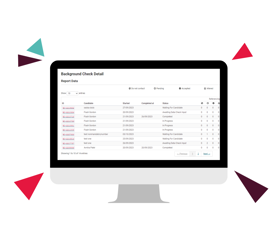
Background check status
This report shows a summary of the statuses of all Background Checks, across each Brand.
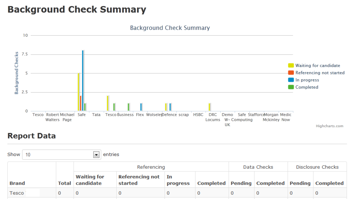
Disclosure Checks
This report displays the statuses of all Disclosure checks, across each brand.
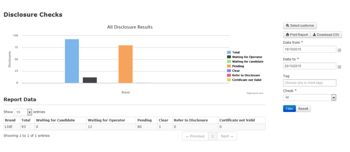
Expiring Documents
This report shows all expiring documents within the system using specific filtering for a brand, document type and date range.
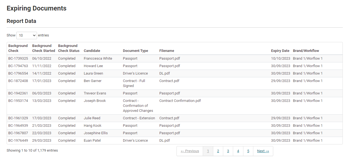
Expenditure by Brand
This report shows an output of the total expenditure per Brand over a period of time.

Expenditure Over Time
This report shows an output of the total expenditure split into weekly amounts over a period of time. The amount details costs for all brands.
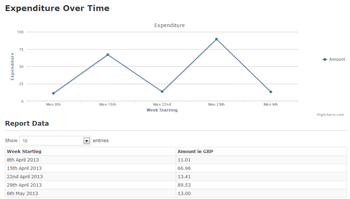
Transactions
This report lists all accrued transactions that can be filtered for a particular Brand, Tag and date range.
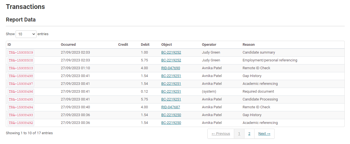
Audit Log
This audit report lists all the actions performed on the system by users, candidates and Referees. This is date and time stamped and can be filtered by user.
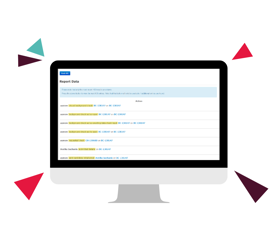
Conclusion
In order to help businesses make efficient and reliable decisions in the hiring process, they need to take notice of the available background screening reports that available to them through automated screening software, as they stand as a necessary pillar of trust for organisations.
Crafting an effective background screening report demands meticulous attention to detail, drawing from various sources across the screening process, and helps to serve as an example of integrity, reflecting the commitment to fairness and transparency throughout the assessment process.
Ultimately, the report is more than just data; it's a tool for building trust, enhancing security, and making decisions grounded in knowledge and integrity. As we navigate a complex world, let us recognise the pivotal role played by background screening reports in shaping a future founded on reliability and trust.
